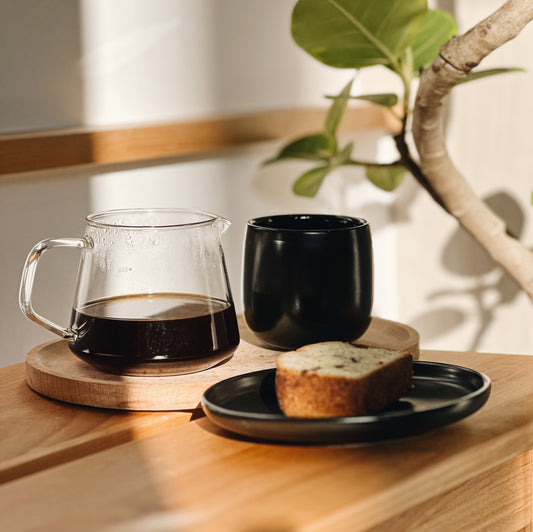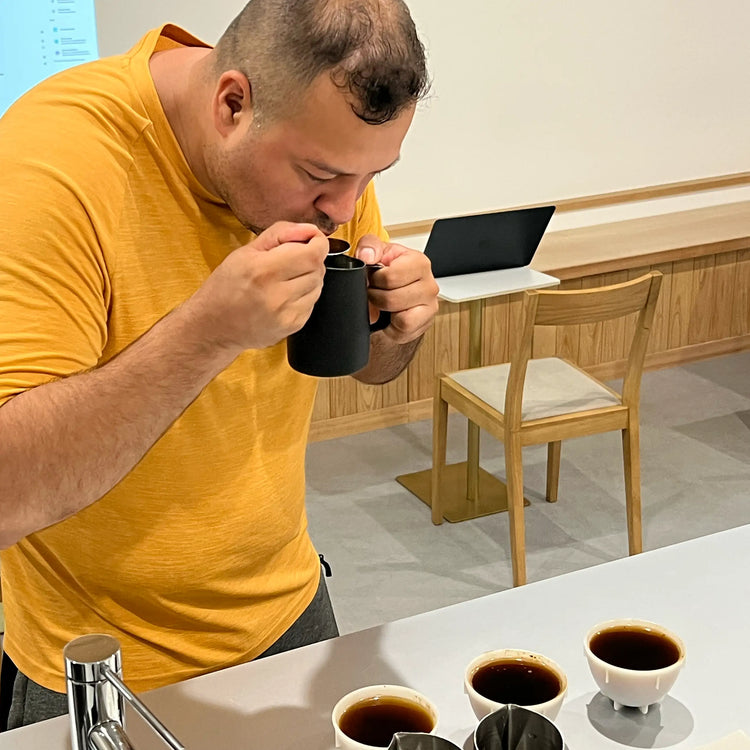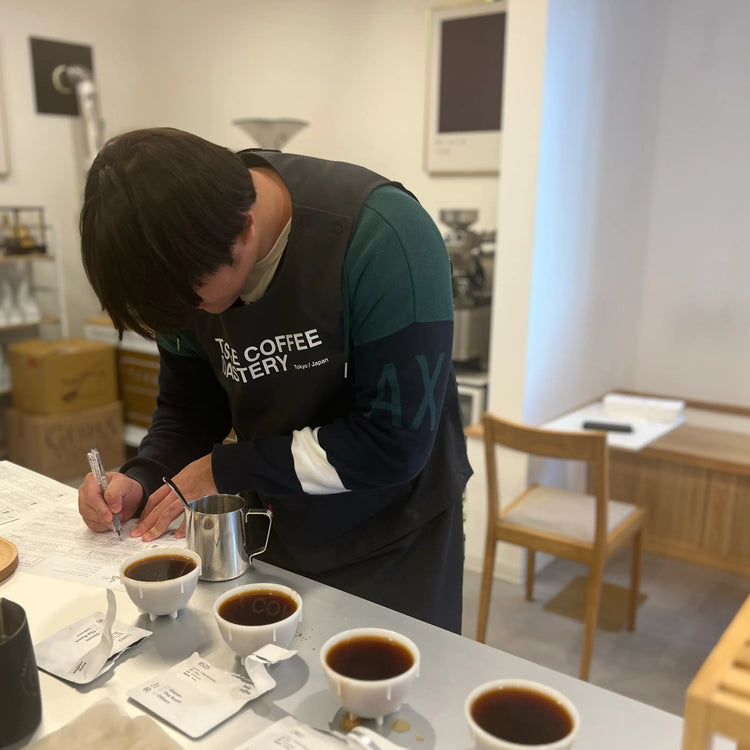For any questions, please contact us at hello@tasse-coffee.jp, we will reply as soon as possible (within a day)
Description
More
Less
Sensory Coffee Experience Course: Unlock the Secrets of Coffee Tasting in Tokyo
Embark on an enchanting sensory adventure through Tokyo's vibrant coffee world with our 2-hour workshop. Tailored for tourists, travelers, and curious coffee enthusiasts, this experience delves into the art of tasting and appreciating coffee, helping you discern what makes a cup truly exceptional.
No prior knowledge required—just an open palate and a love for coffee! You'll explore flavors, aromas, and nuances in a fun, interactive way, leaving with the skills to evaluate coffee like a pro. Enjoy tastings of premium Tokyo-roasted beans and special discounts to take home your favorites. This isn't just a class; it's a delightful Tokyo memory for anyone eager to savor the deeper side of coffee. Book now and awaken your senses to the magic of great coffee!
Duration: ~2 hours (flexible based on group pace)
Check Availability: See starting times
Instructor: English / Japanese / Chinese
Group Size: Small group limited to 4 participants (minimum 2 participants required)
Experience Highlights:
- Discover how to identify and appreciate coffee flavors through guided sensory exercises.
- Uncover the science behind what makes coffee "good" or exceptional.
- Participate in interactive tastings to compare and evaluate different coffees.
Course Structure with Taste and Learn Details
-
Introduction to Coffee Sensory Basics
-
What You Will Taste:
- A small cup of different taste as a baseline to introduce coffee aroma and taste.
- A small cup of different taste as a baseline to introduce coffee aroma and taste.
-
What You Will Learn:
- The role of the five basic tastes (sweet, sour, salty, bitter, umami) and how they interact with aroma to form coffee flavor.
- How sensory evaluation uses sight, smell, taste, and touch to judge coffee quality.
- Basic terminology (e.g., "acidity" as brightness, "body" as mouthfeel) to start appreciating coffee nuances.
-
What You Will Taste:
-
Basic Tastes and Intensity Exploration
-
What You Will Taste:
- Four coded solutions of sucrose in water: From least sweet to most sweet to practice identifying sweetness.
- Four coded solutions of citric acid in water: From least sour to most sour to explore sourness.
-
What You Will Learn:
- How to identify and rank basic tastes (e.g., sweetness, sourness) by intensity, a skill to detect balance in coffee.
- The connection between taste intensity and coffee quality (e.g., balanced acidity enhances enjoyment).
- Practical tips to cleanse the palate (e.g., water sips, spitting) for accurate tasting at home.
-
What You Will Taste:
-
Aroma Identification and Practice
-
What You Will Taste:
- 10-15 aromas from the Le Nez du Café kit sniffed blindly.
- A brewed coffeeto link aromas to coffee
-
What You Will Learn:
- How orthonasal olfaction (sniffing) reveals coffee’s complexity (e.g., floral hints from high-altitude beans).
- Techniques to match aromas to descriptors using a simplified flavor wheel.
- Why aroma is key to perceiving "good" coffee (e.g., clean, distinct scents vs. muddy off-notes).
-
What You Will Taste:
-
Descriptive and Preference Tasting
-
What You Will Taste:
- Two brewed coffees: few attributes, medium-light roast and many attributes, medium-light roast.
- A small taste of each with a palate cleanser (water) between.
-
What You Will Learn:
- How to describe coffee attributes (e.g., acidity as bright citrus, body as light or full) on a 0-10 scale.
- The difference between objective description (e.g., "high acidity") and subjective preference (e.g., "I like it").
- How to connect taste preferences to quality (e.g., balanced flavors indicate good processing).
-
What You Will Taste:
-
Difference Detection and Quality Check
-
What You Will Taste:
- A triad set : 2 identical coffees and 1 odd coffee
- A comparison to check quality.
-
What You Will Learn:
- How to spot subtle differences (e.g., fruity vs. nutty) using a simple triangulation method.
- What makes a coffee "good" (e.g., no defects, balanced profile) vs. "off" (e.g., over-roasted bitterness).
- Basic quality check skills to apply when buying or brewing coffee.
-
What You Will Taste:
Description
Sensory Coffee Experience Course: Unlock the Secrets of Coffee Tasting in Tokyo
Embark on an enchanting sensory adventure through Tokyo's vibrant coffee world with our 2-hour workshop. Tailored for tourists, travelers, and curious coffee enthusiasts, this experience delves into the art of tasting and appreciating coffee, helping you discern what makes a cup truly exceptional.
No prior knowledge required—just an open palate and a love for coffee! You'll explore flavors, aromas, and nuances in a fun, interactive way, leaving with the skills to evaluate coffee like a pro. Enjoy tastings of premium Tokyo-roasted beans and special discounts to take home your favorites. This isn't just a class; it's a delightful Tokyo memory for anyone eager to savor the deeper side of coffee. Book now and awaken your senses to the magic of great coffee!
Duration: ~2 hours (flexible based on group pace)
Check Availability: See starting times
Instructor: English / Japanese / Chinese
Group Size: Small group limited to 4 participants (minimum 2 participants required)
Experience Highlights:
- Discover how to identify and appreciate coffee flavors through guided sensory exercises.
- Uncover the science behind what makes coffee "good" or exceptional.
- Participate in interactive tastings to compare and evaluate different coffees.
Course Structure with Taste and Learn Details
-
Introduction to Coffee Sensory Basics
-
What You Will Taste:
- A small cup of different taste as a baseline to introduce coffee aroma and taste.
- A small cup of different taste as a baseline to introduce coffee aroma and taste.
-
What You Will Learn:
- The role of the five basic tastes (sweet, sour, salty, bitter, umami) and how they interact with aroma to form coffee flavor.
- How sensory evaluation uses sight, smell, taste, and touch to judge coffee quality.
- Basic terminology (e.g., "acidity" as brightness, "body" as mouthfeel) to start appreciating coffee nuances.
-
What You Will Taste:
-
Basic Tastes and Intensity Exploration
-
What You Will Taste:
- Four coded solutions of sucrose in water: From least sweet to most sweet to practice identifying sweetness.
- Four coded solutions of citric acid in water: From least sour to most sour to explore sourness.
-
What You Will Learn:
- How to identify and rank basic tastes (e.g., sweetness, sourness) by intensity, a skill to detect balance in coffee.
- The connection between taste intensity and coffee quality (e.g., balanced acidity enhances enjoyment).
- Practical tips to cleanse the palate (e.g., water sips, spitting) for accurate tasting at home.
-
What You Will Taste:
-
Aroma Identification and Practice
-
What You Will Taste:
- 10-15 aromas from the Le Nez du Café kit sniffed blindly.
- A brewed coffeeto link aromas to coffee
-
What You Will Learn:
- How orthonasal olfaction (sniffing) reveals coffee’s complexity (e.g., floral hints from high-altitude beans).
- Techniques to match aromas to descriptors using a simplified flavor wheel.
- Why aroma is key to perceiving "good" coffee (e.g., clean, distinct scents vs. muddy off-notes).
-
What You Will Taste:
-
Descriptive and Preference Tasting
-
What You Will Taste:
- Two brewed coffees: few attributes, medium-light roast and many attributes, medium-light roast.
- A small taste of each with a palate cleanser (water) between.
-
What You Will Learn:
- How to describe coffee attributes (e.g., acidity as bright citrus, body as light or full) on a 0-10 scale.
- The difference between objective description (e.g., "high acidity") and subjective preference (e.g., "I like it").
- How to connect taste preferences to quality (e.g., balanced flavors indicate good processing).
-
What You Will Taste:
-
Difference Detection and Quality Check
-
What You Will Taste:
- A triad set : 2 identical coffees and 1 odd coffee
- A comparison to check quality.
-
What You Will Learn:
- How to spot subtle differences (e.g., fruity vs. nutty) using a simple triangulation method.
- What makes a coffee "good" (e.g., no defects, balanced profile) vs. "off" (e.g., over-roasted bitterness).
- Basic quality check skills to apply when buying or brewing coffee.
-
What You Will Taste:
You May Also Like










